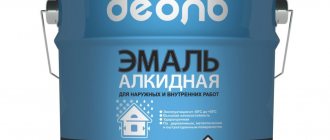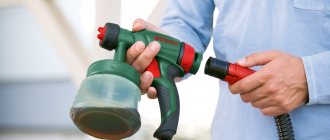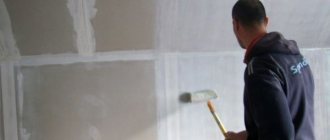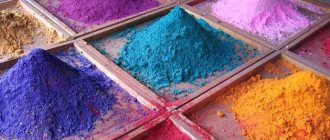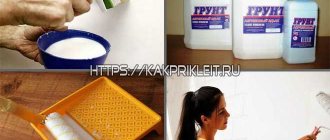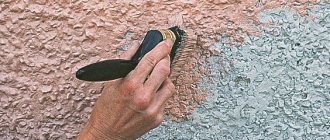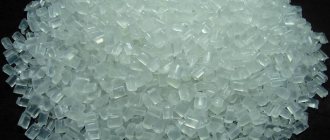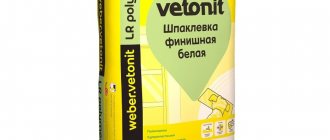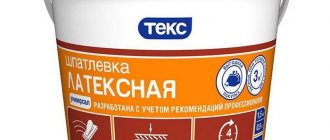Are there “universal” paints with the same surface drying time?
The answer is clear - no. Universality is just a myth used by unscrupulous manufacturers solely for advertising purposes. At best, you buy paint with a one-time or very short-term effect. Therefore, you should not believe the manufacturer’s promises that the paint is equally ideal for repairing the paint surface of a car, for heating radiators, and for decorating a kitchen or bedroom. An excellent result will only be achieved if the paint is used for a specific purpose. In other cases, you will get a mediocre result and simply throw money away.
Often, when choosing, the decisive question is how long the paint takes to dry. This is objectively and directly related to its composition and the environmental conditions in which drying should occur. Why is it important? The pace of paint and varnish work has a direct impact on the overall speed of repair. For example, it is not recommended to carry out any other finishing work while the paint is drying. Otherwise, dust and other construction debris will simply stick to the painted surface.
How long does oil paint take to dry?
Oil-based paints traditionally take the longest to dry. In recent years, manufacturers have abandoned the use of natural drying oil for such compositions. Now in the mass production of oil paints, alkyd or pentaphthalic bases are used. This reduced the drying time of oil paints to one day.
Complete hardening of one layer occurs only as a result of oxidation of the upper oil layer. Factors that matter here include:
- air temperature;
- humidity;
- presence of direct sunlight.
Oil paints with the addition of antiseptic compounds take longer to dry. The period of time sufficient for drying of such and similar paints is indicated to the manufacturers on the can. In any case, drying time is at least 12 hours.
Is it possible to paint with oil paint over oil paint?
Is it possible to paint with oil paint over oil paint? Many property owners who decide to refresh the color of the walls ask this question. This option is optimal if you need to skip the stage of removing the old coating. To get better adhesion, it is advisable to sand the base, removing the glossy layer.
To get better adhesion, it is advisable to sand the base, removing the glossy layer.
Enamels and nitro paints
For most of these compositions, coating with a second layer is allowed within 20-30 minutes after applying the first layer. It takes about the same time for the second layer to dry. Manufacturers allow up to 12 hours for complete hardening so that painted products can be used.
Please note that nitro-based paints dry faster than enamels. This is also due to the primary areas of use of nitro paints and enamels. The former are mostly intended for painting metal and plastic surfaces (provided that the solvent in the paint base does not “eat” the plastic). Enamels can be used to cover any surface, including wood.
Sergey Yurievich
Construction of houses, extensions, terraces and verandas.
Ask a Question
For PF 115 enamel, for example, the drying time is directly related to the thickness of the layer applied during painting and the color of the paint. For example, it will take 48 hours for cherry and red enamel to dry. For everyone else, 24 hours is enough.
How long does it take for water-based emulsions to dry?
Water is considered the most environmentally friendly solvent for paints. Water-based emulsions, called water-dispersion paints, are used to paint almost any indoor surface.
For primary polymerization, 2-3 hours are enough. Complete drying within 24 hours. Some manufacturers produce water-dispersion paints with a complete drying time reduced to 12 hours. It is important that in conditions of high humidity, the drying time of water-based paints is practically unlimited.
Pay attention to the need for preliminary surface preparation for applying water-based emulsions. Otherwise, the dye layer may be completely absorbed into the surface being painted, leaving no traces of color on it or leaving only uneven stains.
Interestingly, water-based paint on the ceiling dries faster than on the walls. This is due to the fact that warm air currents always rise to the top, creating more favorable conditions for paint drying. But it takes at least 24 hours for complete drying.
Does the release form and method of application to the surface matter for paint drying?
The correct answer is yes. Paints in spray cans (aerosol) dry faster if they are applied to the surface in a thin layer.
Surfaces with a high level of porosity, for example, cement-sand plasters, also deserve special attention. Outwardly, it may seem that the paint on them has dried, but in fact it is far from dry. If painting is done on lime plaster, the consequences may be even worse due to the chemical reaction of lime with the paint base.
"Synthetics"
In 1956, melamine began to be added to alkyd resins. Melamine-alkyd enamels have long had a common name: “synthetics”. Why? One version is due to the fact that synthetic fatty acids were used to create the alkyd part of these enamels. Melamine alkyd enamels are produced under the ML marking.
During the curing of these enamels, two processes also occur simultaneously: evaporation of the solvent and the formation of an irreversible film. The second process also occurs with the participation of two components: an alkyd component modified with vegetable oil (or a solution of polyester resin) and melamine-formaldehyde resin. Both of these components are initially located in the same jar, for the time being without reacting with each other.
Unlike classic alkyd enamels, the alkyd component in melamine-alkyd enamels contains few double bonds, so it (the alkyd component) here practically does not react with oxygen. But this component necessarily contains units with reactive hydroxyl groups OH, and when the temperature rises, they react with the methylol groups of the melamine alkyd resin...
Simply put, with sufficient heat, a reaction occurs between the two components, in which the melamine-formaldehyde resin acts as a hardener.
As a rule, the required heating temperature for enamels is 130°C (for example, for Vika-syntal ML-1110). With this heating, the enamel dries in only 30 minutes.
Because of this feature, melamine alkyd enamels are also called “heat-drying enamels.” The advantages of this mechanism are obvious: unlike oxygen curing, here polymerization occurs evenly over the entire thickness of the layer. As a result, a durable irreversible film is formed, which in its physical and visual characteristics is not much inferior to acrylic (we’ll talk about it later) - but only under the condition of high-temperature drying in a chamber.
Since under conditions of repair painting it is impossible to achieve such high temperatures as at the factory, special isocyanate-based drying accelerators were used to reduce the drying temperature of these enamels. These unique “hardeners” were a good help for craftsmen who painted with “synthetics”.
Often in garages they painted with “synthetic” and without drying at all. Naturally, in this case one could not even dream of a tolerable quality of coating, but in conditions of shortage, when getting hold of “ML-coy” was not an easy task, many were happy with this. And besides the car, one could find something to paint with it. For example, a boat, a dacha, windows, railings...
The era of alkyd enamels and their modifications lasted until the mid-70s. Whatever one may say, these materials, with their long drying time and the need for hot drying, were also far from ideal. And progress went further...
Hammer paint
Initially, this type of paint and varnish materials (LPMs) was used exclusively for application to industrial equipment. This type of dye received its name - hammer - due to the external similarity of the texture to the surface after hand-chasing with a hammer.
The composition is based on acrylic, alkyd-styrene or epoxy fillers. Additives include fine glass and aluminum powder. Due to them, particularly high strength of coatings is ensured after drying. It has a characteristic metallic sheen, which is why it is called metallic.
Advantages of acrylic paints
Why are acrylic paints and varnishes so popular? The fact is that they have the following positive qualities, which became the basis for the development of popularity:
- The composition does not contain substances with an unpleasant odor, which ensures environmental friendliness and safety during use.
- A large assortment of colors is provided, so depending on your need, you can choose the most attractive option.
- Simplicity and ease of application is an important positive property that allows you to avoid spending a lot of time on finishing coatings.
- The substance dries quickly, eliminating any loss of integrity.
- A long service life is ensured, thereby eliminating the need for regular restoration and repair work.
Thanks to such positive properties, the popularity of acrylic paint began to rapidly increase. Therefore, many consumers are wondering whether it is possible to coat a surface that was previously treated with nitro enamel with acrylic paint?
Acrylic car paints
For the base of this type of paintwork materials, manufacturers use acrylic resins of synthetic origin. The advantages of their use are high thermostaticity (up to +180 degrees C) and complete neutrality to alkaline and acidic environments, alcohol and water. They practically do not fade when exposed to direct sunlight.
Ideal for coating metal car bodies, forming a particularly durable polymer film on the surface after drying. When applied to the body, a hardener is added to the base. Hardening of the layer on the surface of the car body occurs within 20 minutes, provided that the painting work is performed in a specially equipped paint booth with a high air temperature inside. But it takes 24 hours to dry completely.
The Montana paint deserves special attention. It takes only 15 minutes to dry on the surface of the car body.
Age of Alkyd
The next stage in the history of car painting is associated with the advent of alkyd enamels. This happened at the turn of the 30s and 40s. Over the next 30 years, these enamels were the main paint and varnish material both on the assembly lines of automobile factories and in repair shops. The production of alkyd enamels was carried out by all leading manufacturers of paints and varnishes, including such giants as BASF and PPG.
Compared to nitro paints, alkyds have a number of technological advantages. They have a higher dry residue, so applying five to ten layers of enamel is unnecessary, two or three are enough. There is now no need for constant polishing of the coating - after complete curing, the alkyd enamel forms an irreversible film with high hardness, gloss and resistance to gasoline, oils, precipitation and sunlight.
What is alkyd enamel? The basis of these paints is alkyd resin - a product of the interaction of polyhydric alcohols and polybasic acids (combine fragments of the words alcohol (alcohol) and acid (acid) and you will understand the origin of the term “alkyd”).
The most common alkyd resins are glypthal resins (a product of the reaction of glycerin (trihydric alcohol), phthalic anhydride and vegetable oil) and pentaphthalic resins (pentaerythritol (tetrahydric alcohol) plus the same phthalic anhydride). Based on these resins, Russian paint and varnish manufacturers produce varnishes and enamels marked GF and PF. You may have come across jars with this marking in hardware or construction stores. These are classic alkyd materials.
Just do not confuse construction and household alkyd enamels with those intended for car repair. As an example of car repair “alkyds” we can cite the well-known Finnish enamel, we can recall the enamel “Vika-alkyd” (Vika-60) from.
Alkyd enamels cure naturally. Oxygen from the air takes an active part in this process (therefore, such enamels are often called “air-drying enamels”). Only, unlike nitro paints, here, in addition to physical drying (evaporation of the solvent), another process occurs in parallel: a chemical reaction of converting binder molecules into polymer.
To start the second, chemical process, the interaction of two reactive components is necessary. One of these components is found in the paint can - it is a solution of alkyd resin modified with vegetable oil. Vegetable oil supplies the product with “tails” of higher unsaturated fatty acids containing conjugated double bonds.
The second component is air oxygen. It interacts with these double bonds, resulting in the appearance of radicals that “trigger” the “cross-linking” reaction. Moreover, the presence of several double bonds in each molecule of the alkyd component leads to chain growth and branching and the formation of network structures that form the basis of a durable polymer film. It is impossible to dissolve such a film after it has completely cured, which is why it is called irreversible.
Alkyd enamels are considered one-component (they are supplied in one can), but from a physico-chemical point of view they can be considered two-component, since two components are always involved in their curing: alkyd resin and oxygen.
The very mechanism of curing of alkyd enamels also determines their main drawback: a very long curing time. Since the access of oxygen into the layer becomes more difficult as it cures, complete polymerization of alkyd enamel throughout its entire depth occurs in a few weeks at best. And the film obtained after the first time of painting is the result of only primary polymerization.
But these enamels are unpretentious in work; painting with them is convenient and easy. Due to the high content of solvents, a surface film quickly forms during the application process, so in order to create smudges, you still need to try. For these reasons, some craftsmen can still use alkyd enamels in certain cases. For example, to quickly and inexpensively refresh your used car before selling it. It turns out beautifully, but the new owner will have to think about the rest...
How long does it take for floor paint to dry?
If you are going to paint the floor, quick-drying acrylic enamels are perfect. In just a few hours you can begin to use the room, however, to ensure complete drying, it is recommended not to subject the floor surface to mechanical stress for at least 12 hours.
If you used oil paints the old-fashioned way, you need to check the drying time on the paint cans. Let us remind you once again that different manufacturers indicate different drying periods, this depends on the composition of the paint itself and some environmental factors.
When using PF 266 paint for the floor, application should be carried out only on dry, primed surfaces. The drying time of the first layer is at least 24 hours, after which the second layer can be applied. Complete drying of each layer – 24 hours.
Silicone paint and drying time
The drying time for silicone paint at home is from several hours to several days. This process is influenced by a number of environmental factors - primarily humidity and air temperature,
If you dry products in a special chamber, during the first hour the air temperature should be raised to 100 degrees, and during the second hour - to 200 degrees. For complete drying in such conditions, 2 hours are enough.
You can ask your question to our author:
Features of tinting silicone paint
By thoroughly mixing, bring the paint into working condition. If a silicone dye is chosen as a consumable material, its composition can be tinted by adding colored pigments. To eliminate possible errors, select colors and dosage of dye in a small volume.
After receiving a positive result, tint the main volume in compliance with the proper proportions. Thin paint only with compatible thinner. The quality of the coating largely depends on the uniformity of the paint composition. You will save working time if you use a mixer or attachment on a household drill to mix the mixture.
